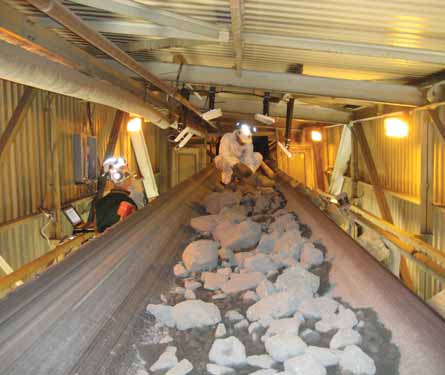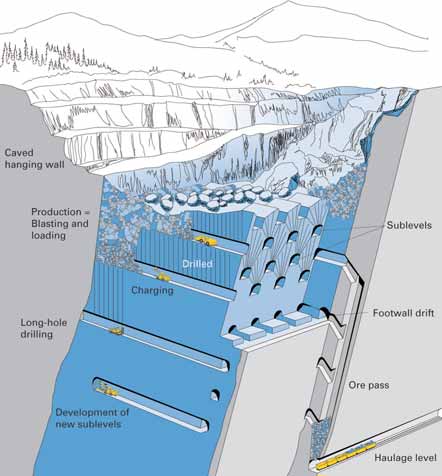
Technicians test RFID readers above a conveyor at Stobie mine. The readers will identify
RFID tags in ore to determine grade.
Vale Inco Tracks Ore with RFID Tags
Stobie mine monitors ore grade from the muck pile to the mill
By Steve Fiscor, Editor-in-Chief

Traditionally, a geologist visits the sublevel drift prior to the blast and determines the amount of dilution in the ore. A set of ore grade slips are filed and recorded into an ore modeling system and the mine has a rough idea of what it has stored where and what’s moving through the main haulage. This manual form of ore tracking, however, is far from ideal.
Vale Inco’s Frood-Stobie mine recently started testing an ore tagging system that uses disposable radio frequency identification (RFID) tags, or “ore pills” as they are commonly called, to track ore in real time. A geologist visits each blast site and tosses a few ore pills into the muck pile and a network of strategically placed RFID readers tells the mine what ore is moving where; it also tells the mine the average ore grade in the railcars; and it tells the concentrator what to expect.
Some of the benefits are obvious. Knowing head grades allows the mining company to more accurately forecast production. Anticipating those grades, the mill could optimize its circuitry. If a mill is processing ores from multiple locations, the system could also assist with blending ore to help the mill optimize more effectively.
Tracking Ore at Stobie
Located on the south side of the
Sudbury Basin, the Stobie mine produces
copper, nickel, and precious
metals. It mines ore from six zones with
two shafts (with the deepest to the
4,075 level). Underground, the miners
use sublevel caving and vertical retreat
mining techniques. On average the
mine extracts 3 million metric tons per
year (mt/y) of ore. Stobie, along with
five other mines, ships ore to the
Clarabelle mill, which produces a copper-
nickel concentrate. The concentrator
processes 33,500 mt/d or about 9.5
million mt/y.
As the name implies, the surrounding country rock is allowed to cave and the ore is extracted through sublevels, which are mined through the ore body at a regular vertical spacing. Each layer has a parallel set of drifts across the ore body. Ore passes are developed at strategic locations along the sublevels to connect to the main haulage level. Longhole rigs drill rings vertically in a fanned pattern from the drifts into the ore body. On the upper most sublevels, blasting starts at the hanging wall and retreats toward the footwall. As one layer moves closer to the footwall and subsides, the next layer repeats the process below the caved area. Ore fills the draw points and LHDs haul it to the ore pass.
“Our sustaining objectives here at the Stobie mine facility are to leverage technology systems to improve our operations,” said Mark Palkovits, senior geological technologist at Vale Inco’s Stobie mine. “The RFID system provides a unique ability to monitor ore throughout the extraction process. It allows us to better understand this process and make more timely decisions in this regard.”
The goal of the new system was to track ore as it travels from the blast site to the mill. A geologist places ore pills at the blast. These reinforced RFID tags are enclosed in plastic and correspond to a location with associated geological information. As the ore makes its way to the surface, the RFID tag is recorded. The data is processed and re-associated to the blast site.
“The beat geologist will put the RFID tags in different muck sources underground,” said Palkovits. “He will also place them in miscellaneous places such as road bed and waste rock. That helps the mine get a better handle on quality control as far as what’s coming up. Prior to this, if waste material was entering the ore stream, there was no way to measure it. So this system will give us a little better handle on external dilution sources.”
The ore passes at Stobie can hold as much as 100,000 mt. Depending on what area of the mine the ore pass is located, that could amount to two months of production. “As the ore passes discharge, estimating the grade can be difficult,” said Palkovits. “In any given month, the grade can swing 0.5% copper and 0.5% nickel at the Stobie mine.” The residence time is often long. But, by using this RFID tagging system, the information about the ore in these passes is stored in it.
The current grade control system consists of tags filed every shift by the scoop operators that tell what work place they worked and how many buckets they moved. “A geologist assigns so much dilution to the ore at each blast site,” Palkovits said. “We have a number of ore passes, however, and by the time the ore mixes and reaches the surface, no one can be sure of what exactly is coming out of the mine. How can you improve if you don’t know for sure what you are measuring?

Currently, the geologists are placing two or three tags at each muck source until the mine gets a better handle on read rates. “If we find we are reading all of the tags, then we might reduce that to one or two,” said Palkovits.
For years, the handful of mining companies using sublevel caving methods have been performing marker study trials. “Metal plates are placed between the blasthole rings,” Palkovits said. “The steel plates are recovered with a magnet at the crusher. They can use these plates to determine what percentage of the muck came from each level in the sublevel cave. Part of the problem, however, is the mine doesn’t necessarily know when the plate entered the stream.
“Ideally what we would do is put a series of RFID tags between each set of rings—maybe have a tag every foot and that would give a 3-D location,” Palkovits said. “The scoop would have an RFID reader and tag, and the mine would monitor the number of trips to the ore pass and when it reads the ore tags the mine would know an X-Y-Z location from which it came. The marker study trials could be enabled with flow models. It would generate a live system that would tell the mine what passed and when.”
Ore Tagging System
The Stobie mine worked with Ship2Save
to develop the system. “The value that
this system provides is the ability to
understand the dynamics of the excavation
process,” said Konrad Konarski,
director of alliances at Ship2Save Inc.
The system consists of Avery Dennison
Ultra-High Frequency (UHF) RFID tags,
Motorola, Inc. mobile and fixed UHF
readers, along with Ship2Save’s RFID
Raw Material Tracking software.
Environmental specifications, customer requirements and radio frequency regulations demanded a systemic development approach to deliver a costeffective and comprehensive solution, Konarski explained. “The Vale Inco project brought together subject-matter experts from across multiple industries, including tag manufacturing, injection molding, RFID reader manufacturing, software development and of course mining,” Konarski said.
This is a rather unique RFID application for mining. “Usually, in mining, RFID tags are used for tracking personnel or assets,” Konarski said. “This UHF chip technology is very cost effective from a cost per tag perspective. Advances in readability and read ranges makes this possible. This system was not an option from a cost or read point of view even a year or two ago.” The tags are all Generation 2E PC compatible and they all use the same infrastructure (i.e., protocol and reader devices). In open air, the ore pills would have a read range of 15 ft. On a conveyor belt, however, they are buried under ore that contains metal, which creates interference.